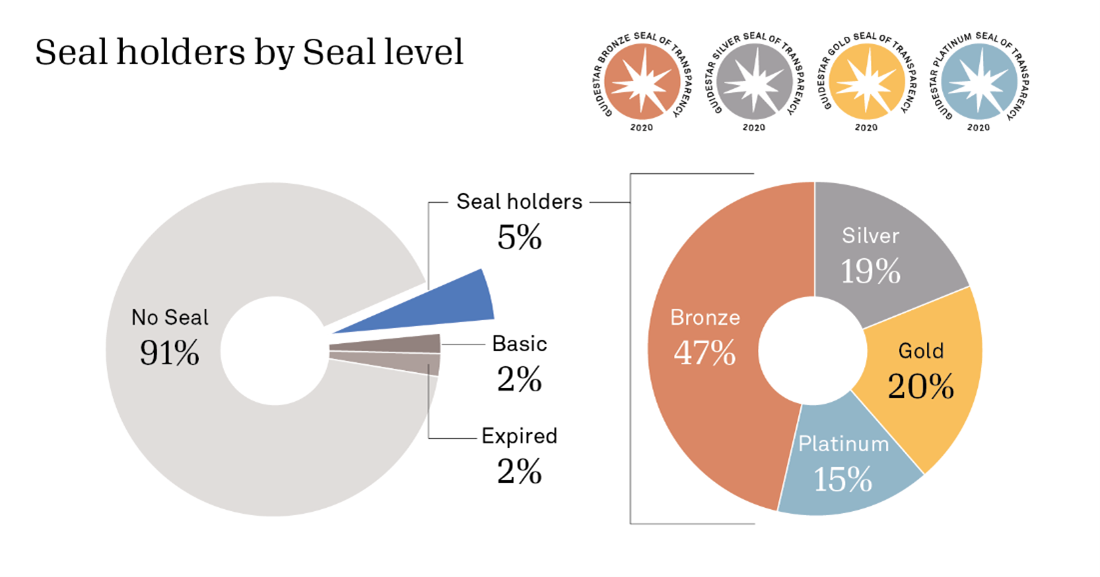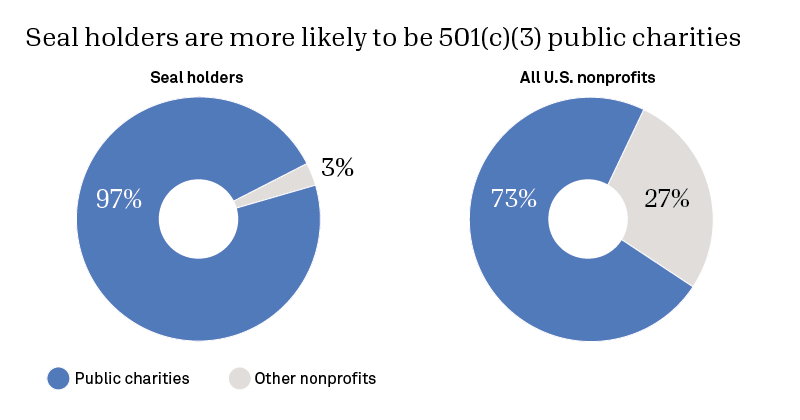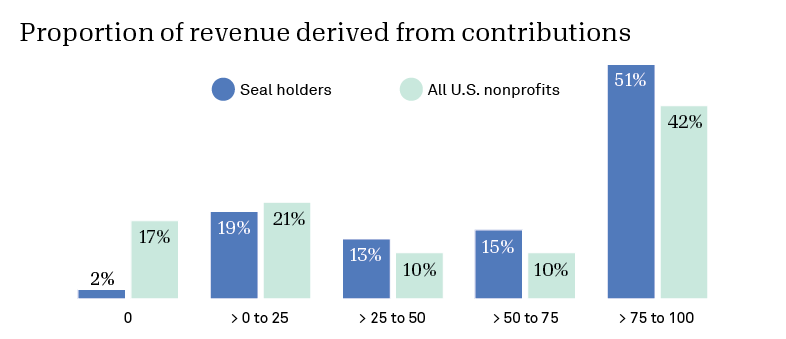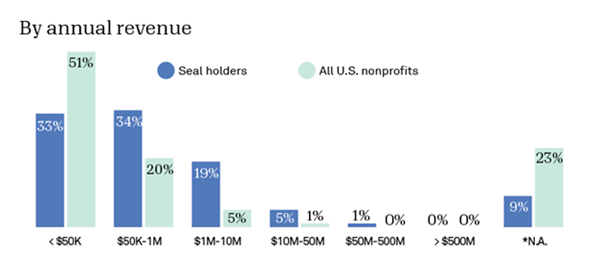A look at organizations that have earned GuideStar Seals of Transparency

At Candid, we believe that transparency and the flow of information between social sector actors are fundamental to a vibrant, successful, and trusted sector. We recognize that transparency is multi-dimensional and can be practiced in different ways. For example, nonprofit IRS filings—IRS Forms 990, 990-EZ, 990-PF, and 990-N, which U.S. tax-exempt organizations must file annually—are an impressive source of public information. In fact, Candid centers much of its work on collecting, standardizing, and making this data available.
But a lot of the questions we—and you—have about the nonprofit sector go beyond the information provided on an IRS Form. Whom are nonprofits serving with their programs? How are they thinking about impact measurement? Which nonprofits are led by people of color?
The GuideStar Seals of Transparency
We introduced the GuideStar Seals of Transparency in 2013 to address these questions and to provide visible recognition when a nonprofit shares information on GuideStar. More than 75,000 organizations have earned Seals, making the GuideStar Seal the most widely adopted symbol of transparency in the U.S. social sector.
The type of information a nonprofit provides determines which Seal it earns. The levels are:
- Bronze—basic information so your organization can be found
- Silver—program information and brand details
- Gold—financials and people information
- Platinum—goals and the difference you’re making
A nonprofit must earn Bronze before it can earn Silver, Silver before it can earn Gold, and Gold before it can earn Platinum. Check out the full list of requirements.
What we know about the Seal holders
In late 2020, we analyzed the organizations that participate in the Seals program. Here’s what we learned.
How many?
At the time of our analysis, 78,262 organizations had a Seal. They represented about 5 percent of the more than 1.7 million nonprofits registered with the IRS. Nearly half of Seal holders had earned a Bronze Seal. The proportion holding Silver, Gold, and Platinum Seals varied, sometimes daily, as nonprofits added information to earn the next Seal level. Our snapshot found 19 percent of Seal holders were at the Silver level, 20 percent at Gold, and 15 percent at Platinum.
Beyond this active Seal holder group, a smaller number of organizations had claimed their profiles but not earned a Seal (giving them “basic” status) or had allowed their Seals to expire (organizations must provide updated information on an annual basis to maintain their Seals).

What type of nonprofits?
All nonprofits that are tax exempt under IRS section 501(c) can earn a Seal, but Seal holders are overwhelmingly 501(c)(3) public charities—the type of organization most people think of when they hear the word nonprofit. Public charities account for 97 percent of Seal holders but only 73 percent of all U.S. tax-exempt nonprofits.

Nonprofits with Seals depend more on contributions as a primary source of revenue than the average nonprofit. We found that about two-thirds (66 percent) of Seal holders derive over half of their revenue from contributions (vs. 52 percent of nonprofits overall). Other sources of funding we track include program service revenue (income generated by activities that directly carry out an organization’s mission), investments, and sales of inventory.[i]

Private foundations also hold Seals of Transparency. As of late last year, 1,512 foundations had earned Seals, 369 of them at the Gold or Platinum level. These organizations generally do not engage in fundraising, which suggests they earned Seals to demonstrate their commitment to transparency. Foundation Seal holders include the Bill & Melinda Gates Foundation (Platinum), David & Lucile Packard Foundation (Silver), and the MacArthur Foundation (Bronze).
Seal holders were larger on average, but thousands of very small organizations participated in the program, too. Seal holders accounted for 5 percent of nonprofits overall but represented about 10 percent of all nonprofit revenue. Although the concentrations of both Seal holders and nonprofits fall on the smaller end of the scale, one-quarter of Seal holders earned more than $1 million in annual revenue, vs. just 6 percent of all nonprofits.

About 47 percent of Seal holders received at least one grant from a U.S. funder in 2017-2018.[ii] Taken from another angle, 19 percent of all U.S. grant recipients were Seal holders, but the grants they received represented 32 percent of the overall $104 billion in grants dollars. This means that, on average, Seal holders received more grantmaking dollars than organizations without Seals.

A little or a lot of transparency?
At first glance, the fact that 5 percent of U.S. nonprofits had a Seal may seem quite small. There’s incredible diversity of size and revenue models across the nonprofit sector, however. When we limit the pool to those that fit a more “typical” nonprofit profile (specifically, public charities with annual revenue > $200,000, assets >$500,000, and that depend on contributions for at least 30 percent of revenue), the proportion of nonprofits with Seals increased to 23 percent. In other words, nearly one in four “typical” nonprofits shared up-to-date information about their internal workings with Candid.
So, is a Seal of Transparency for you?
The motivations and incentives for joining the Seal holder program vary. Some organizations want to reach new donors and funders or maintain information donors frequently request in a single place. There is evidence that taking time to update can be a good investment—independent research has linked having a Seal to a 53 percent increase in contributions.
If your organization already has a GuideStar profile, then yes, you can and should earn a Seal of Transparency. Earning a Bronze Seal takes less than five minutes. This guide will help you get started.
Thank you for your commitment to transparency!
________________
[i] A subset of nonprofits provides information about the amount of revenue they derive from different sources—i.e., contributions, service revenue, investments, sales of inventory, etc.—on their IRS filings. Revenue by source is limited to organizations that filed a Form 990 or 990-EZ and have total revenue > $0. Additionally, organizations reporting zero or negative revenue were excluded from this part of the analysis.
[ii] As a point of comparison, the proportion of all U.S. nonprofits that received a grant in 2017 is calculated at 18% (see Key Facts on U.S. Nonprofits and Foundations). This is likely an undercount recognizing that Candid databases may not have captured all grants awarded by U.S. Foundations.








Lexie says:
Hello! Is there updated data for 2023 or 2022?
Kristin Boe says:
Hi Ray, please feel free to visit Candid’s GuideStar platform (https://www.guidestar.org) for extensive information on nonprofits.
Over 1.8 million nonprofits are included on Candid’s GuideStar. A growing number of organizations have earned a Candid Seal of Transparency. A seal indicates that an organization has demonstrated a level of transparency by providing additional information about their finances, operations, and activities; it is not a rating or an endorsement. Our goal is to give people access to the unbiased information they need to make informed giving decisions.
Learn more about how to give wisely to nonprofits: https://candid.org/about/press-room/media-kit/five-steps-to-better-giving.
Learn more about Candid’s Seals of Transparency: https://blog.candid.org/post/introducing-2023-candid-seals-of-transparency.
Ray Czaszwicz says:
How does one look up a charity's rating by name? AND... What ratings
organizations are the most reputable? I click on ratings websites, and
can't call up the charity's I want to look into. There are so many scams
out there, that I'm hesitant to check a charity's website, for fear of them
posting misinformation in order to secure more donations.
Kate, Digital Communications Manager, Candid says:
We changed the look of the seal to reflect the new organization, Candid, instead of being focused on GuideStar. You can learn a little more about these on our webinar on the new seals: 2022 Candid Seals of Transparency.
Our Biswas says:
The look of the seal has changed with Candid word.
Any reason?